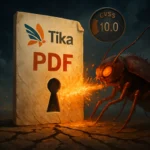A critical security vulnerability dubbed NvidiaScape (CVE-2025-23266) has been discovered in Nvidia’s Container Toolkit, threatening the security of AI cloud services worldwide. The flaw, identified by Wiz security researchers, carries a maximum CVSS score of 9.0, indicating an urgent need for immediate remediation across affected systems.
Understanding the NvidiaScape Container Escape Vulnerability
The vulnerability stems from improper handling of Open Container Initiative (OCI) hooks within Nvidia’s container management system. These hooks are specialized mechanisms that execute specific operations during various stages of a container’s lifecycle. The flawed implementation creates opportunities for privilege escalation and breaks down critical isolation barriers between containers.
The security flaw affects multiple Nvidia products, including all versions of Container Toolkit up to and including 1.17.7, and GPU Operator versions prior to 25.3.0. Nvidia has responded swiftly by releasing patched versions 1.17.8 and 25.3.1 respectively, addressing the container escape vulnerability.
AI Cloud Infrastructure at Risk
The NvidiaScape vulnerability poses particular dangers to managed AI services in multi-tenant cloud environments where multiple users share GPU infrastructure resources. Attackers can exploit this flaw using specially crafted containers to completely bypass isolation mechanisms and achieve root-level access to host machines.
Successful exploitation of this container escape vulnerability can result in several severe consequences. Unauthorized access to confidential data belonging to other cloud tenants represents a primary concern. Additionally, attackers may manipulate proprietary AI models, execute denial-of-service attacks against critical infrastructure, or compromise data integrity in shared computing environments.
Real-World Demonstration at Pwn2Own Berlin 2025
The vulnerability gained significant attention following its public demonstration at the prestigious Pwn2Own Berlin competition in early 2025. The Wiz research team successfully showcased the exploit using a simple three-line Docker file containing malicious payload, earning a $30,000 reward for their discovery and demonstration of the container escape technique.
This demonstration highlighted the practical exploitability of the vulnerability and underscored the immediate threat it poses to production AI cloud environments utilizing Nvidia’s GPU infrastructure.
Mitigation Strategies and Security Recommendations
Nvidia has issued comprehensive security bulletins informing users about available patches and remediation steps. System administrators should immediately update to the secure software releases to protect against potential container escape attacks. The patching process should be prioritized for environments hosting sensitive AI workloads or multi-tenant configurations.
Beyond immediate patching, security experts emphasize implementing defense-in-depth strategies. Organizations should not rely solely on container isolation as their primary security boundary. Hardware-level virtualization and additional isolation layers provide crucial supplementary protection, especially in multi-tenant AI cloud environments.
Long-term Security Architecture Considerations
The NvidiaScape incident highlights fundamental security architecture principles for modern cloud infrastructures. Regular security audits of containerized platforms become essential, particularly for organizations handling critical AI applications and sensitive data processing workloads.
Container security strategies should incorporate multiple isolation mechanisms rather than depending exclusively on container-level boundaries. This approach proves especially critical for AI cloud services where valuable intellectual property and sensitive customer data require robust protection against sophisticated attack vectors.
The discovery of NvidiaScape demonstrates the evolving threat landscape facing AI cloud infrastructure. Organizations must adopt comprehensive security frameworks that combine timely patch management, architectural best practices, and continuous monitoring to protect against container escape vulnerabilities and maintain the integrity of their AI-powered services.






